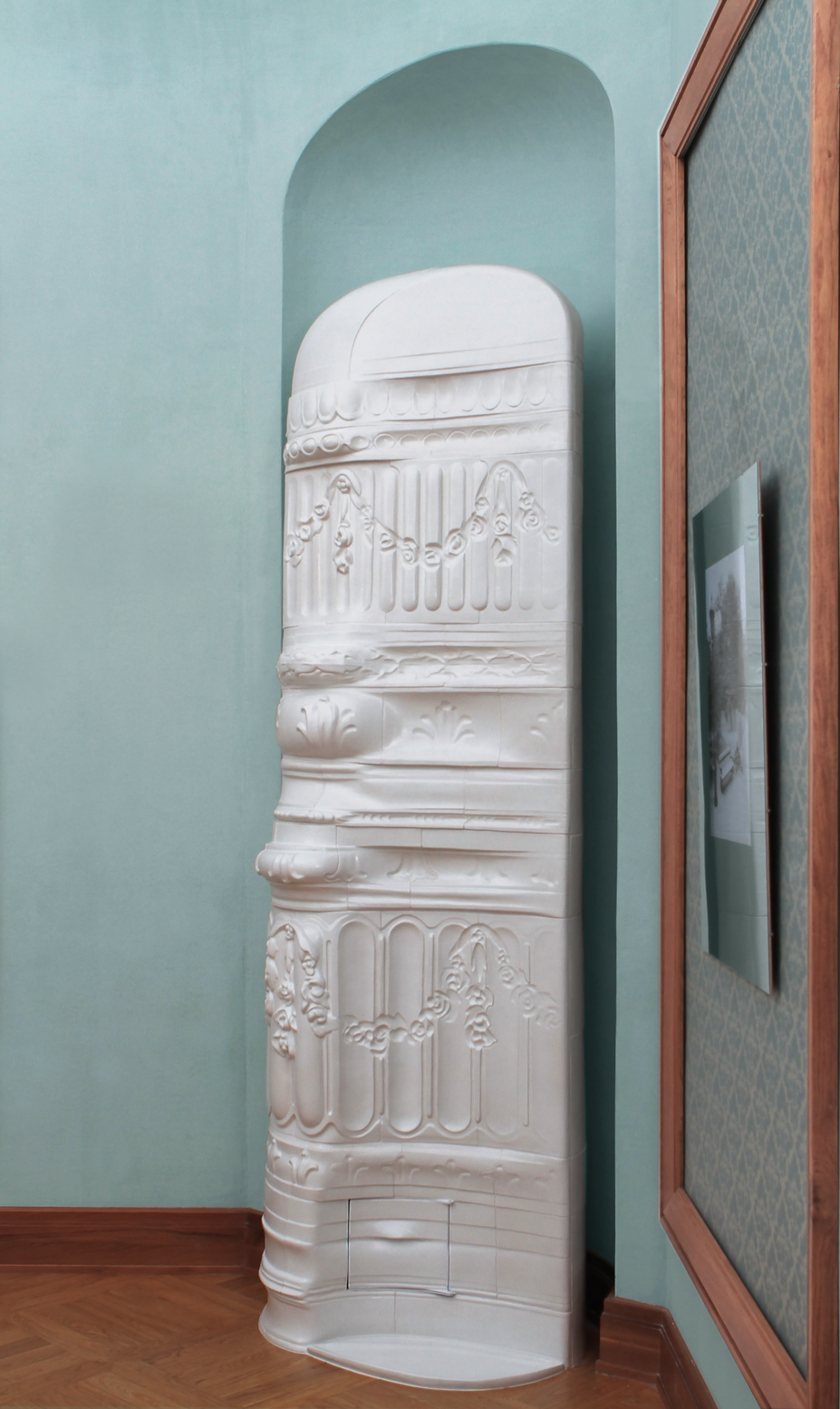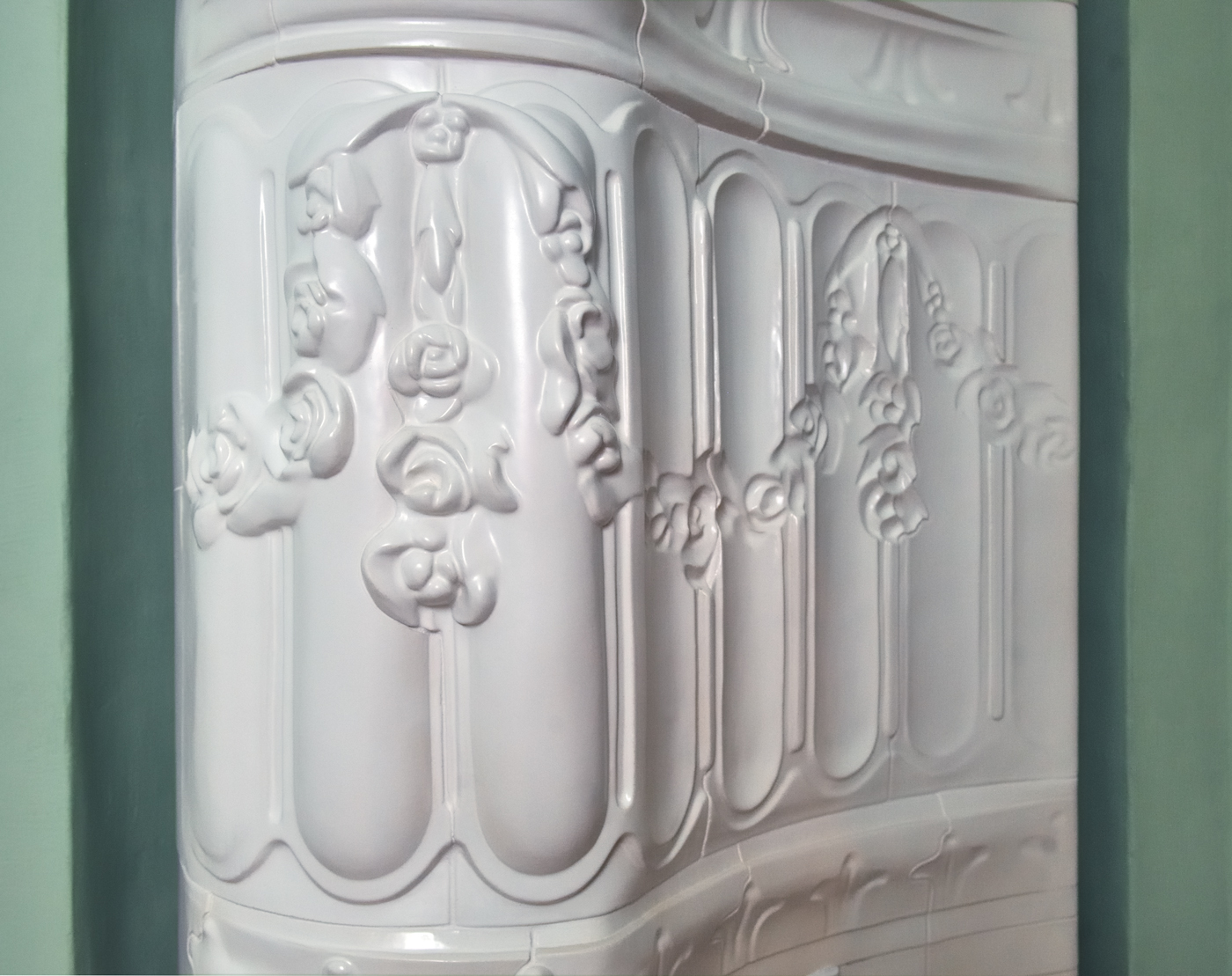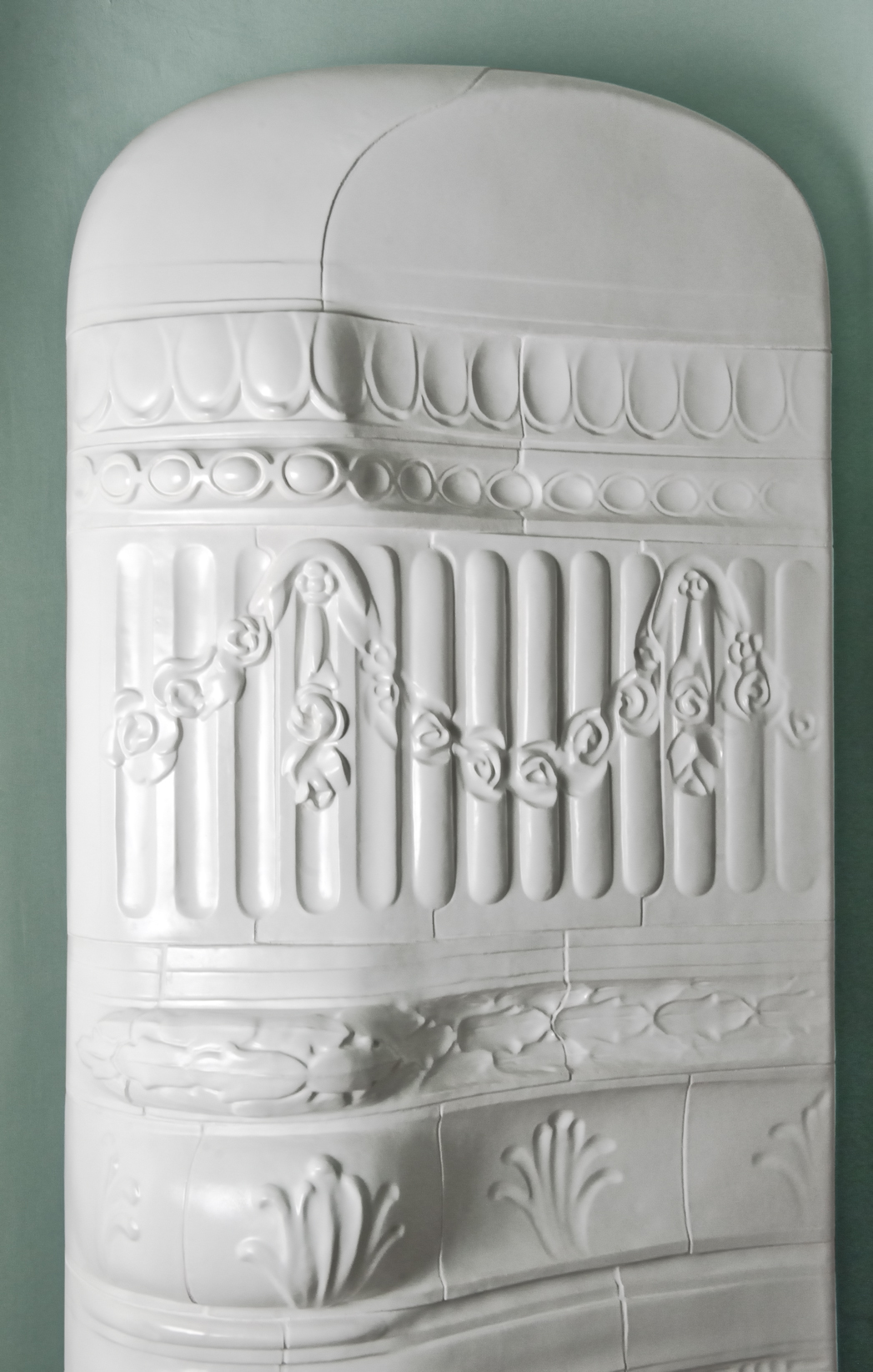The new stove reconstructs the functions of baroque-era stoves: display and heating, in the baroque stylistic-structural tradition.
My design concept was that, in light of the absence of information, the reconstruction of the original stove was impossible – and as such it was necessary to indicate that the piece is new, not original to the baroque era.
The elements of the new stove were made using a baroque-era technological process: the individual slabs were pressed into forms. Following baroque tradition, the grout lines that mark the seams on the surface run mostly hidden in the pattern.
APPEARANCE
Material: glazed chamotte mass
Size: 85x70x300 cm
The new stove is an memory of a baroque-era stove, its “imprint”
We know the Ráday castle in Pécel to be an András Mayerhoffer design executed during the same period, also in the Grassalkovich style, suggesting that the stoves in the Laffert-kúria were built by the same masons. The ornamentation of one of three original zopf stoves preserved in the Ráday castle suited the proportions required for the new stove, and as such served as inspiration for the designer.
Masonry stoves stood in the corners of the late-baroque formal rooms of the Laffert manor house in Dunaharaszti. Research by art historians determined that the stoves were of the zopf baroque style, however no further recollections emerged. As such the design direction for the reconstruction became a reinterpretation of the baroque, making use of the proportions and motifs of historical zopf-style masonry stoves in Hungary. In the case of the Laffert-kúria, the aim of the reconstruction was not merely to copy a baroque stove, but to reinstate the dual function of the original: both to provide heat, and to represent the status of the family. In accordance with baroque era tradition, multiple stoves can be manufactured in a short run series, ready to fill voids in further baroque interior rehabilitation projects.
Reconstruction and Reinterpretation
During the reconstruction of masonry stoves often a design is being copied from a well-known castle, or a contemporary piece purchased, which in fact has no connection to the given site. In neither case can it be considered an authentic reconstruction. A well-known and excellent example is the Neues Museum rehabilitation in Berlin, where the rehabilitation of the war damaged historical building adopted a contrasting approach: the extant historically significant elements were completed with contemporary pieces made with modern materials. In cases where a lack of information makes reconstructing the original masonry stove impossible, the design concept calls for identifying the replacement as a new, non-baroque item, and in contrast with the above examples my approach was to use stylistic paraphrase to solve this problem.
Baroque Spacial Concepts and Masonry Stoves
A typical feature of baroque construction in castles and manor houses is the enfilade, which is a sequence of spaces opening onto one another through doors aligned on an axis, and served by recesses or niches for masonry stoves. Specialized heating corridors and niches were created to separate the living quarters from the firebox. The narrow corridor of the Laffert-kúria was at one time such a heating corridor, from which the servants fed the stoves in the living quarters. The masonry stove of two adjacent rooms was heated from a shared fire box. Today the function of the building’s rooms is different; as such the stove must be fed from within the room. The wall cavity intended for the stove suggested the basic form for the stove’s design.
Location: The Laffert-kúria (Granárium) in Dunaharaszti was built by Baron Ferdinánd Antal Laffert in the beginning of the 18th century. It was likely designed by András Mayerhoffer in theGrassalkovich baroque style. Rehabilitation of the estate became necessary after the 20th century saw it sacked and fall into ruin. The European Union funded project, led by Atelierachitects and completed from 2010-2011, included restoration of the manor house, the roads adjacent to the main facade, and the remaining gardens.
Paraphrase
When designing and creating the new stove, Edit Szabo began with the principles of baroque composition, such as symmetry, distortion, illusory effects, non-planar composition/stage-set like qualities, transitionality and contrast. These fundamental principles of design may also coincide or overlap. Since it is not possible to know the original shapes of the stoves of the Laffert-kúria, the new stove takes the shape of its niche. The niche is an elliptical, negative space – essentially a depression in the wall. Elliptical forms are an identifying feature of baroque spatial composition, given that during the baroque period central domed spaces (for example, the floorplans of churches) were transformed into elongated, oval spaces. The elongation of the new stove also signals that it is a contemporary paraphrasing of the baroque. The new piece is a memory of, or imprint of a baroque era masonry stove.
The creation of illusory effects was a key element of baroque form. The original plasticity of the sample stove only appears in a certain area of the new stove, in section. Where the body of the stove curves into negative space, there the ornamental pattern also becomes negative. This transition of the ornament from positive to negative creates an unreal spatial effect. Another important element of the baroque style is non-planar composition, creating a stage-set like quality. When entering the room from one door, we see the protruding form of the stove, but when entering from the other door, we perceive the concave, or negatively plastic side. When viewing the stove from the front, we see the positive and negative surfaces simultaneously. Contrast, as a defining characteristic of the baroque, emerges from this shift in form from positive to negative and the corresponding play of shadow and light. The fine detail of the design conveys transitionality – a deeply baroque trait.
As part of the reinterpretation, the Laffert-kúria stove was constructed using the techniques of the baroque period. At the time tiled masonry stoves were constructed in large format divisions built up on framework or pressed into wooden forms. Edit Szabo’s technique was similar with the exceptions that a plaster press form was created instead of wood, and the piece was fired in an electric kiln rather than a wood-fired one. The divisions of the stove and its grout lines followed the ornamental pattern wherever possible, in order to minimize their visibility. In addition to assembling the stove, Master Stove Builder István Silárszky consulted regarding the design of the firebox, the divisions of the stove, and the concealed door. The assembly of the individual pieces took eight days.
The Laffert-kúria’s paraphrased-baroque stove was made possible by the support of the National Cultural Fund (NFK).
My thanks to the architectural firm, Atelierarchitects, and to the designers of the reborn Laffert-kúria, architects Kiss-Gál Zsuzsa and Kiss-Gál Gergő, for their continual support during the entire process. My thanks also to silicate chemical engineer Költö András for his assistance in creating the glaze, tool engineer Veszeli Zoltan for his help with the metal work, and finally to the city government of Dunaharaszti and project coordinator Novák Anikó. Photos by Dániel Kováts.

















